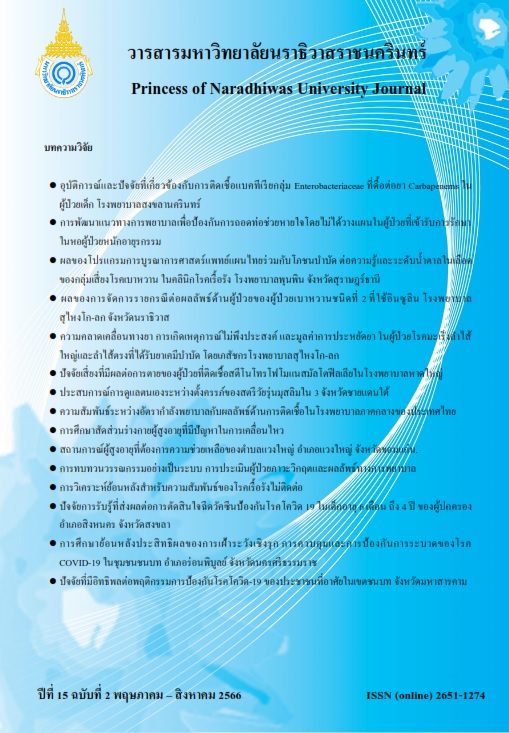การทบทวนวรรณกรรมอย่างเป็นระบบในการประเมินผู้ป่วยภาวะวิกฤตและผลลัพธ์ทางการพยาบาล
คำสำคัญ:
การทบทวนวรรณกรรมอย่างเป็นระบบ, การประเมินผู้ป่วยภาวะวิกฤต, ผลลัพธ์ทางการพยาบาลบทคัดย่อ
การทบทวนวรรณกรรมอย่างเป็นระบบนี้มีวัตถุประสงค์เพื่อสรุปองค์ความรู้ งานวิจัย วิธีการปฏิบัติที่ดีการประเมินผู้ป่วยภาวะวิกฤต และผลลัพธ์ทางการพยาบาลผู้ป่วยภาวะวิกฤต จากรายงานวิจัยตั้งแต่ปี พ.ศ. 2554 ถึง พ.ศ. 2564 โดยใช้การทบทวนวรรณกรรมอย่างเป็นระบบของ The Joanna Briggs Institute For Evidence Based Nursing & Midwifery (2016) ผลการสืบค้นอย่างเป็นระบบพบงานวิจัยผ่านเกณฑ์การคัดเลือกทั้งหมด 8 เรื่อง เป็นการวิจัยเชิงทดลอง จำนวน 1 เรื่อง การวิจัยกึ่งทดลอง จำนวน 2 เรื่อง การวิจัยเชิงสังเกตจำนวน 4 เรื่อง และการวิจัยเชิงบรรยายจำนวน 1 เรื่อง เครื่องมือที่ใช้ในการวิจัย คือ แบบประเมินคุณภาพงานวิจัยและแบบสกัดข้อมูล ใช้การวิเคราะห์สรุปเชิงเนื้อหา ผลการทบทวนวรรณกรรมอย่างเป็นระบบ พบว่า การใช้การประเมินสัญญาณเตือนในระยะแรกก่อนเข้าสู่ภาวะวิกฤต พบว่า ผลคะแนน 1, 2 คะแนน มีโอกาสรอดชีวิตสูงสุดร้อยละ 85.5 ผลการใช้การประเมินอวัยวะล้มเหลวจากการติดเชื้อในกระแสเลือดแบบเร็ว ผลคะแนนมากกว่าหรือเท่ากับ 2 สามารถทำนายอัตราการตายทั้งในและนอกหอผู้ป่วยหนัก ผลการใช้แบบประเมินคะแนน APACHE II และ APACHE III พบว่า การตายของผู้ป่วยต่ำกว่าอัตราการตายตามเกณฑ์ APACHE II ในระดับคะแนนเดียวกันอย่างมีนัยสำคัญทางสถิติ (p < 0.001) และผลการใช้แบบประเมินผู้ป่วยภาวะวิกฤตตามกรอบแนวคิดของ FANCAS ในนักศึกษาพยาบาล พบว่า นักศึกษาพยาบาลมีความรู้ความสามารถในการใช้แบบประเมินประเมินสภาพผู้ป่วยภาวะวิกฤตจากรูปแบบ FANCAS อยู่ในระดับปานกลาง (X = 3.38, S.D = .741) การทบทวนวรรณกรรมอย่างเป็นระบบในครั้งนี้จะเป็นประโยชน์สำหรับบุคลากรทางการแพทย์นำไปประยุกต์ใช้ในการประเมินผู้ป่วย เพื่อให้เกิดผลลัพธ์ทางการพยาบาลที่ดีขึ้น
เอกสารอ้างอิง
Banchongchad1, S., Ongprakrit1, J., & Jaleanlap, P. (2022). Effect of using Nakornping Early Warning Score (NEWS) to surveillance for variations change and warning signs for patients in male surgical department 1 Nakornping Hospital, Chiang Mai Province. Journal of Nursing and Public Health Research, 2(1), 47-59.
Chuaychang, S. (2018). Effects of using the assessment of the modified early warning signs (MEWS) in the assessment and monitoring change symptom of patients in cardiac catheterization lab, Trang hospital. Thai Journal of Cardio-Thoracic Nursin, 29(1), 72-83.
Chumsri, J. (2020). Nursing care of patietnts with burn and inhalation injury: 2 case study. Journal of Khon Kaen Provincial Health Office, 2(2), 248-264.
Holloway, N.M. (1988). Nursing the Critically III Adult (3rd ed). California: Addison-Wesley.
Kaewpeth, U. (2021). The effectiveness of the Modified Early Warning Scores (MEWS) for Surveillance of patients before entering crisis inpatients department Sikhio Hospital Nakornratchasima Province. Region 11 Medical Journal, 35(1), 1-11.
Kaewsingha, P., Akavipat, P., Prasertsong, K., & Pannak, S. (2012). Neurosurgical Intensive Care Unit ffective outcomes measurement with Acute Physiology and Chronic Health Evaluation (APACHE) III. Medical Journal of Srisaket Surin Burirum Hospital, 27(3), 205-216.
Khwannimit, B., & Geater, A. (2007). A Comparison of APACHE II and SAPS II Scoring Systems in Predicting Hospital Mortality in Thai Adult Intensive Care Units. Journal of the Medical Association Thailand, 90(4), 643-652.
Maitra, S., Som, A., & Bhattacharjee, S. (2018). Accuracyc of quick Sequential Organ Failure Assessment (qSOFA) score and systemic inflammatory response syndrome (SIRS) criteria for predicting mortality in hospitalized patients with suspected infection: a meta-analysis observational study. Clinical Microbiology and infection, 24(11), 1123-1129.
Nakchuay, N., Inprasong, L., Tuntrakul, W., Tongbai, P., & Juntanu, P. (2017). MEWS: Adult Pre-Arrest Sign and Roles of Nurse. Siriraj Medical Bulletin, 10(3), 186-190.
Onsawadipong, P. (2020). The effects of modified sequential organ failure assessment compared with modified early warning score in sepsis patients at Intensive Care Unit. Journal of Nursing Division, 47(2), 88-103.
Pothidara, Y., & Thanyasawad, T. (2020). Effects of using a critically ill patients’ assessment from according to FANCAS concept in nursing practicum course. Nursing Journal, 47(2), 463-475.
Rhodes, A., Evan, LE., ALhazzani, W., Levy, MM., Antonelli, M., Ferrer, R., ... Dellinger, R.P. (2017). (a). Surviving sepsis campaign: international guideline for management of sepsis and septic shock. Intensive Care Medicine, 43(3), 304-337.
Rhodes, A., Evan, LE., ALhazzani, W., Levy, MM., Antonelli, M., Ferrer, R., ... Dellinger, R.P. (2017). (b). Surviving sepsis campaign: international guideline for management of sepsis and septic shock. Critical Care Medicine, 45(3), 486-552.
Ritklar, L. (2016). The Results of using the evaluation form for early warning signs on unplanned ICU admission and mortality rate in internal medicine ward at Thammasat University Hospital. TUH Journal online, 1(1), 5-12.
Saleh, A., Ahmed, M., Sultan, I., & Abdel-lateif, A. (2015). Comparison of the mortality prediction of different ICU scoring systems (APACHE II and III, SAPSII, and SOFA) in a single-center ICU Subpopulation with acute respiratory distress syndrome. Egyptian Journal of Chest Disease and Tuberculosis, 64, 1-6.
Suttichan, K., Phithaksilp, M., Prueksaritanond, S., & Jaidee, W. (2018). Outcome of quick Sequential (Sepsis-related) Organ Failure Assessment criteria compare with Chachoengsao’s Sepsis Screening criteria in patient with infection at Bangpakong hospital. Burapha Journal of Medicine, 5(1), 13-27.
The Joanna Briggs Institute for Evidence Based Nursing & Midwifery. (2016). Joanna Briggs Institute Reviewer’s Manual: 2016 edition. Retrieved August 29, 2021 from http://www.joannabriggs.edu.au/Documents/sumari/Reviewers%20Manual-2016 Pdf
The Joanna Briggs Institute. (2020). (a). Critical Appraisal Tool Checklist for Randomized Controlled Trials. Retrieved August 29, 2021 from https://jbi.global/critical-appraisal-tools
The Joanna Briggs Institute. (2020). (b). Critical Appraisal Tool Checklist for Quasi-Experimental Studies. Retrieved August 29, 2021 from https://jbi.global/critical-appraisal-tools
The Joanna Briggs Institute. (2020). (c). Critical Appraisal Tool Checklist for Analytical Cross-sectional Studies. Retrieved August 29, 2021 from https://jbi.global/critical-appraisal-tools
Thompson, K., Venkatesh, B., & Finfer, S. (2019). Sepsis and septic shock: Current app roachesto management. Internal Medicine Journal, 49, 160-170.
Tunanuchittikul, Y. (2014). Application of APACHE II scores in the General Intensive Care Unit, Lampang Hospital. Journal of Health Science, 23(2), 1-7.
William, A. K., Elizabeth, A. D., Douglas, P. W., & Jack, E. Z. (1985). APACHE II: a severity of disease classification system. Critical Care Medicine, 13, 818-29.
Zhou, X., Ben, S., Chen, H., & Ni, S. (2015). A comparison of APACHE II and CPIS scores for the prediction of 30-daymortality in patients with ventilator-associated pneumonia. International Journal of Infectious Disease, 30, 144-147.
ไฟล์ประกอบ
เผยแพร่แล้ว
รูปแบบการอ้างอิง
ฉบับ
ประเภทบทความ
สัญญาอนุญาต
ลิขสิทธิ์ (c) 2023 วารสารมหาวิทยาลัยนราธิวาสราชนครินทร์

อนุญาตภายใต้เงื่อนไข Creative Commons Attribution-NonCommercial-NoDerivatives 4.0 International License.




